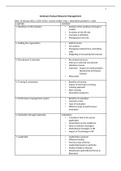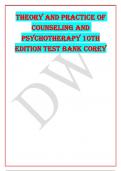1
Summary Human Resource Management
Date: 19 January 2022, 13:00-15:00 | Course credits: 3 stp. | theoretical questions + cases
CHAPTER CONTENT
1. Workforce & HR evolution • Analysis of the workforce through 3
models
• Evolution of the HR role
• Concepts & definition
• Management and role
2. Staffing the organization • Staff structure
• Job analysis
• Managing productivity & controlling
costs
• Budgeting & forecasting the business
3. Recruitment & selection • Recruitment process
• Internal vs external recruitment
• Selection process
• Interview: Impact of communication
Questioning techniques
Content
• Afterwards
4. Training & orientation • Benefits of training
• Impact of learning on training
• Training approach
• After training
• Orientation programs
5. Performance management system • Benefits of evaluation
• Common errors
• Type of evaluation
• Different steps in performance
evaluation
6. Motivation through leadership motivation:
• 2 models & link to the actual
application
• Generations on the workforce
• How to motivate (manager)
• Motivational strategies in HR
• Impact of Technology in HR
7. Leadership • Leadership in general
• Different models:
• Formal versus informal
• Leadership based on authority
• Model of Blake & Mouton
• Situational Leadership by Hersey &
Blanchard
, 2
CHAPTER 1: WORKFORCE & HR EVOLUTION
1. Evolution of the workforce
The history of HR evolution
Frederic Taylor - US Engineer
His theory of scientific management argued that:
• managers should break down production into a series of small tasks
division of labor -> working in assembly line
• workers should then be trained to do ONE specific task each, so they can
master it
• workers are paid according to the number of items they produce time-
piece-rate pay
as a result, workers are encouraged to work hard to maximize their
productivity (and pay)
Taylor introduced standardization, work analysis and maximalization of production.
It was an autocratic management style: managers give orders & control and workers just
work; they have no say at all.
workers soon started disliking Taylor’s approach as they were only given boring,
repetitive tasks, they felt like machines and had no say in anything
, 3
Elton Mayo – Management Scientist
Put the basis of business sociology, adds a social dimension to work, the human factor
Mayo introduced the Human Relations School of Thought and argued that:
• managers should take more interest in the employees
• managers should treat the employees as people with opinions and realize that
workers enjoy interaction (importance of teamwork)
Mayo concluded that workers are best motivated by:
• having the employees’ social needs met
• better communication between managers – employees
• more manager involvement in employees’ working lives
• working in groups/teams
It was a paternalistic management style: more involvement and having the right to share
opinions
Henri Fayol – Coal mine engineer & director
Academic world: fayolism
Founder of the five functions of management, which is the base for business admin. &
mgmt. concept is still one of the most influential mgmt. concepts
The five principles/steps of management
, 4
1. Planning
Two types of planning: - strategic
- operational
1.1 Strategic planning
Focuses on long-term goals & objectives
Components of strategic planning are: - values statement
- mission statement
- vision statement
Hospitality companies develop these statements to explain why the organization exists
(mission statement), what they expect to become in 10 years or so (vision statement) and
how it shall act in relationships with its stakeholders such as customers and employees
(values statement)
Many companies have one generic policy that contains all three elements
1.2 Operational planning
Business plan: - sales & marketing plan
- action plan (Food & Beverage)
- Human resources plan (social calendar, training & development,
recruitment plan
+ Operational budget
2. Organizing
Sufficient capital, staff and raw materials; Mngmt must make sure that all necessary
resources are put together at the appropriate time of production
-> organigram & strength of staff
-> research & choice of products & suppliers
3. Commanding
mngmt must encourage & direct personnel activity
Successful managers set SOP’s, communicate clearly & audit the results
Clear instructions & Motivate & encourage good work & taking initiative
Help redirecting / coaching when performance not adequate
, 5
4. Coordinating
Harmonize & facilitate
Mngmt must make sure that personnel work together cooperatively, focus on teamwork
5. Controlling
The final mngmt activity is for the manager to evaluate & ensure compliance on accounting,
technical and quality control
Steps to follow:
• measure and report on actual performance
• compare results with planned performance and standards
• take corrective or preventive measures as needed
Summary:
Henri Fayol's management theory :
Today the business community considers Fayol's classical management theory as a relevant guide to productively
managing staff.
Fayol concluded that management should interact with personnel in five basic ways to control and plan production.
1. Planning: management must plan and schedule every part of industrial
processes.
2. Organizing management must also make certain all of the necessary resources
(raw materials, personnel, etc.) come together at the appropriate time of
production.
3. Commanding management must encourage and direct personnel activity.
4. Coordinating management must make certain that personnel works together in a
cooperative fashion.
Foster Team Work
5. Controlling The final management activity for the manager is to evaluate and
ensure that the output respond to the initial plan. IF NOT: analyze the 5 steps
, 6
2. Evolution of the Human Resources role
Organizations are not static evolution of the individual / labor / organization
By changing influences of the society (politics, tech, economy) shift in HRM
Job loss, online
reservations = less need
for reservations staff
Evolution of the HR role:
1) industrial revolution (19- beginning 20th century)
• Many changes & challenges
• Growth of the average income
• Mass production vs hand production (introduction of the machine)
• Social structure changes (war, after war, introduction of unions…)
Human resource’s role = labor manager
• Main focus is productivity, adaptation of the labor force
• Main activities are hiring, payroll, … more of an administrative role
2) 20th century (after war 1945-60)
• Social pressure is rising
• Economic growth
• Scientific progresses
• Immigration and multicultural force
• Social-environmental factors have an influence on production & profitability
(women at work, end of child labor, paid holidays in 1936…)
• A lot of adaptation of the industry to stay in the loop (just like now)
, 7
Human resource’s role = personnel manager
• new missions: focus on hygiene & security, communication/info,
social relations, staff wellbeing (reference to mayo)
• focus is more on human/social aspect
3) As of 1960
• Revision of the Cie (?) organization (employment/recruitment strategy) after
economic crisis
• Link HR w financial outcome & part of Cie strategy
• Importance of workforce (recruitment selection/education – specialist –
growth and training
• Work council progress & social changes and progress
• Start of digitalization
Human resource’s role = human resources manager
• new mission: participate in setting strategy, create
compensation plans, set development/career plan
To summarize, over the years, the Human Resources Manager became :
• Operational to strategic - reactive to proactive
• Qualitative to quantitative - activity focused to solutions focused
• Policing to partnering - functional to business oriented
• Short term to long term - administrative to consultative
, 8
HRM – Main roles
1. Strategy & planning Identify and manage current and future
needs to achieve goals (analysis, metrics,)
2. Compliance Do what is required by law (equal
employment, federal regulations,)
3. Talent management Attract, recruit, retain engaged staff
4. Training & development Improve people and performance (career
planning, training,)
5. Performance management Programs to ensure work of staff contribute
to the mission
6. Rewards Financial/non-fin. Tools to attract and
motivate staff
7. Safety & health Ensure welfare of people at work
8. Employee and labor relations Relationship btw staff, corporate and union
Hospitality and workforce today
Characteristics and challenges of hospitality industry?
Financial crisis, terrorism safety challenges, competition due to new concepts which leads to
difficulty differentiating, new forms of competition (Airbnb), changing guests, varying sizes
of operations to work in, diversity, very labor-intensive industry (24/7 service) and flexible
schedules, seasonality and revenue management, …
Characteristics and challenges of the workforce?
New skill requirements (IT proficient, yield mngmt, automation,)
Unstable workforce (high turnover) because of low educated staff, little career development
opportunities, working conditions, lack of training, young/elder staff, new ways of working,
demographical changes (baby boomers aging, different generations colliding, gen x wanting
more freedom, boomers more traditional…)
3. Concepts and definitions
DEFINITIONS won’t be asked, and if they are, you are allowed to explain them in your own words
Some basic definitions
HR strategy: business plan in HR, translation of business strategy towards the way the
company will select, motivate, and evaluate its workforce to achieve its goals
HR Management: describes systems for mngmt of people within the organization: (HR &
team to incorporate the HR in their job – reference to the 8 roles)
HR Cycle: processes and procedures that constitute the cycle from hiring to leaving





